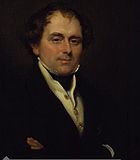
Thomas Fletcher Waghorn
Encyclopedia

Kent
Kent is a county in southeast England, and is one of the home counties. It borders East Sussex, Surrey and Greater London and has a defined boundary with Essex in the middle of the Thames Estuary. The ceremonial county boundaries of Kent include the shire county of Kent and the unitary borough of...
, was a postal pioneer who developed a new route from Great Britain
Great Britain
Great Britain or Britain is an island situated to the northwest of Continental Europe. It is the ninth largest island in the world, and the largest European island, as well as the largest of the British Isles...
to India
India
India , officially the Republic of India , is a country in South Asia. It is the seventh-largest country by geographical area, the second-most populous country with over 1.2 billion people, and the most populous democracy in the world...
. Waghorn's route reduced the journey from 16,000 miles, via the Cape of Good Hope
Cape of Good Hope
The Cape of Good Hope is a rocky headland on the Atlantic coast of the Cape Peninsula, South Africa.There is a misconception that the Cape of Good Hope is the southern tip of Africa, because it was once believed to be the dividing point between the Atlantic and Indian Oceans. In fact, the...
, to 6,000 miles: from three months to between 35 and 45 days.
Waghorn was born in Chatham, England, and baptised at St Mary's Church on 16 July 1800. His father, also Thomas, was a butcher and had married Ann Goodhugh at All Saints' Church, Snodland
Snodland
Snodland is a small town in the county of Kent, England, located on the River Medway between Rochester and Maidstone. It has a population of about 12,000 people....
, on 28 July 1794.
At 12 years of age, Thomas entered the Royal Navy at Chatham, joining HMS Bahama as a midshipman in November, 1812. He married Elizabeth Bartlett at St John's Cathedral, Calcutta, in 1822. He became a pilot and took an interest in the early attempts at establishing a steamship route from England to India and the East. But the East India Company
British East India Company
The East India Company was an early English joint-stock company that was formed initially for pursuing trade with the East Indies, but that ended up trading mainly with the Indian subcontinent and China...
—which effectively ran that continent for Britain—showed a remarkable indifference to his ideas.
After leaving the Navy as a lieutenant in 1832 he made the journey to India via Egypt
Egypt
Egypt , officially the Arab Republic of Egypt, Arabic: , is a country mainly in North Africa, with the Sinai Peninsula forming a land bridge in Southwest Asia. Egypt is thus a transcontinental country, and a major power in Africa, the Mediterranean Basin, the Middle East and the Muslim world...
as an experiment to send mail. Disastrously, the journey took four and a half months— but on his way back he met the Pasha of Egypt, who supported his desert route idea.
Personal tragedy followed in March, 1834, when his wife died in Calcutta. By December, however, Waghorn had remarried—to Harriet Martin, daughter of the miller at Snodland and a neighbour of his mother. That month he also inherited a substantial estate from his grandfather and the couple lived in Rochester until building The Lodge in Snodland’s upper High Street about 1841.
Waghorn's business plan began to flourish. He set up an agency in Cornhill, London, for conveying post—and passengers—to India via Egypt. Between 1835 and 1837 he lived among Arabs in the desert and laid the foundations for the overland route across the desert from Cairo
Cairo
Cairo , is the capital of Egypt and the largest city in the Arab world and Africa, and the 16th largest metropolitan area in the world. Nicknamed "The City of a Thousand Minarets" for its preponderance of Islamic architecture, Cairo has long been a centre of the region's political and cultural life...
to Suez
Suez
Suez is a seaport city in north-eastern Egypt, located on the north coast of the Gulf of Suez , near the southern terminus of the Suez Canal, having the same boundaries as Suez governorate. It has three harbors, Adabya, Ain Sokhna and Port Tawfiq, and extensive port facilities...
. This involved building rest-houses and supplying guides, boats, horses and carriages for travelers.

Waghorn turned his attention to speeding the post in Europe
Europe
Europe is, by convention, one of the world's seven continents. Comprising the westernmost peninsula of Eurasia, Europe is generally 'divided' from Asia to its east by the watershed divides of the Ural and Caucasus Mountains, the Ural River, the Caspian and Black Seas, and the waterways connecting...
, through the new railway system. He was successful, but the Government reneged on a deal to pay his expenses for the trials left him £5,000 in debt.
Waghorn died at his London home in Islington on 7 January 1850. He was buried at All Saints', Snodland, just outside the vestry
Vestry
A vestry is a room in or attached to a church or synagogue in which the vestments, vessels, records, etc., are kept , and in which the clergy and choir robe or don their vestments for divine service....
door. The south wall of the nave bears a memorial to him.
A statue of Waghorn was raised in Railway Street, Chatham, in 1888.

